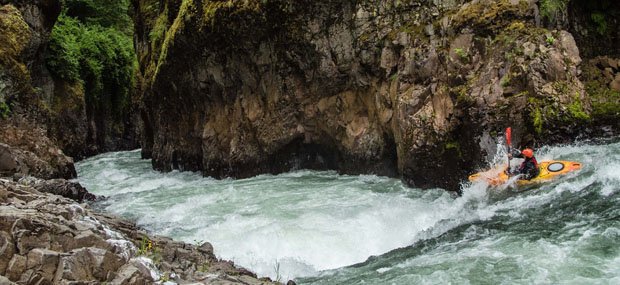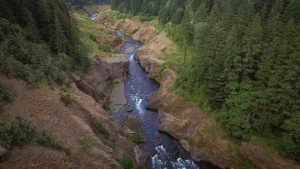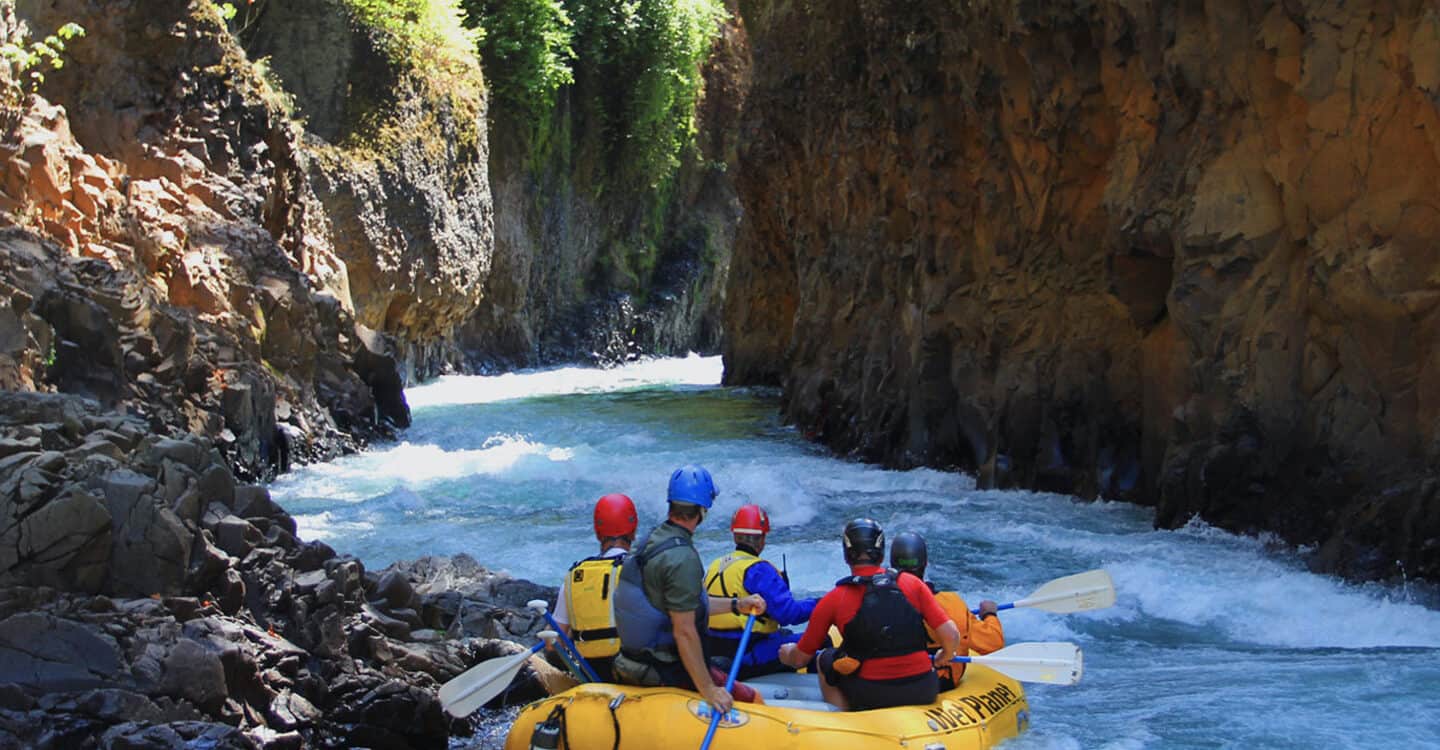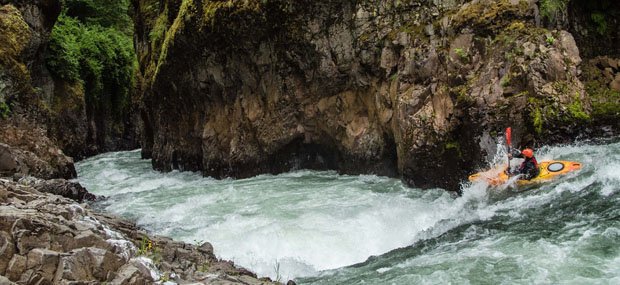
The Narrows on the White Salmon River is not only stunningly beautiful, but also has some action-packed whitewater. Photo: Fred Norquist Paddler: Brendan Wells
After 100 years of what fish biologist call a barrier to fish migration, Pacific Salmon and Lamprey are now able to make it make it further than just three miles upstream the White Salmon River.
With the removal of Condit dam, salmon and the eel-like Pacific lamprey, which can scale vertical waterfalls, now have access to miles of new habitat upstream on the White Salmon River and its many tributaries. At the same time kayakers, rafters, and fisherman alike now have the ability to float downstream all the way to its confluence with the great Columbia River. The deconstruction of Condit dam (the largest dam to be removed in the U.S. at its time), and subsequently its reservoir, once called Northwestern Lake, has resulted in enormous changes to the White Salmon River watershed. The removal is a landmark in the future of restoring salmon runs to the Pacific Northwest, but it goes much further beyond deconstruction. We must now all do our part to help reconstruct the river to its pre-industrial state, a task that is being spearheaded by the organization SHARE.
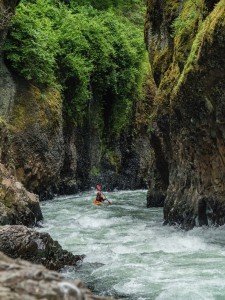
For kayakers, the removal of Condit dam is a unique new opportunity to explore the most beautiful section of the White Salmon River, The Narrows.Photo: Fred Norquist Paddler: Brendan Wells
SHARE is a collective of river users from all walks of life – from landowners to rafting companies, fisherman to fish biologists, kayakers to grassroots river research, stewardship and education organizations. Together, the group has been working to raise awareness and educate the public on four key ways that river users can help restore the White Salmon River to its ancestral state.
1: Wood is good! Woody debris in the river and on the riverbanks is essential habitat for fish and should be left in place whenever possible. When it poses a major hazard for recreational users, wood should be moved by regulatory agencies that will reposition it to a better location.
2: Clean, drain, and dry boats and gear! The White Salmon River (and others) is under MAJOR threat from invasive species from infected rivers like the nearby Deschutes.
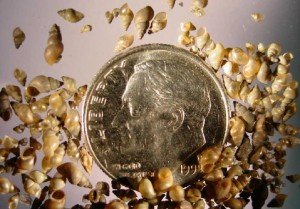
Because some invasive species can reproduce asexually, it only takes ONE tiny specimen like the New Zealand mudsnail to threaten the White Salmon River’s ecosystem! Photo: WDFW
3: Don’t tread on me! Learn to identify and avoid salmon redds and spawning salmon. Salmon are now spawning in the commonly used middle and lower stretches of the White Salmon River and it is critical that we avoid redds or nests of fragile salmon eggs.
4: Leave no trace! Practice leave no trace ethics and respect riverside property owners and other river users.
Learn more about these key concepts and educate your friends! Visit Mid Columbia Fisheries and the Washington Department of Fish and Wildlife to find out more.
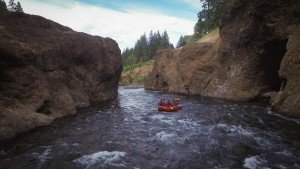
Above, a group of rafters float past where the behemoth concrete wall once blocked the flow of water and salmon for 100 years. Photo: Brendan Wells
Having grown up paddling the White Salmon River since before my teens, it is an exhilarating thought that species like the Pacific Lamprey may now make it all the way upstream to my hometown of Trout Lake, near the birthplace of the White Salmon.
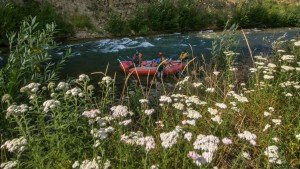
Native species including Yarrow, Willow, Lupine and Cottonwoods have quickly re-established themselves in what was once the reservoir created by Condit Dam. Photo: Brendan Wells
Watching the quick regrowth of the riverside banks gives me great respect for the resilience of rivers if we give them the chance. In just four years since the removal of the dam, the previously submerged riverbanks have transformed into a sea of purple lupine, brilliant white yarrow and cottonwoods that already tower over my head. As native species eagerly sink their roots into long-forgotten soils, salmon fight their way upstream the White Salmon River over waterfalls and through raging whitewater, repopulating the watershed quicker than any fisheries experts could have ever imagined.
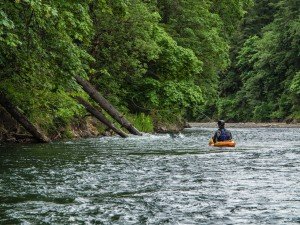
Drew Swisher targets Steelhead Salmon on the White Salmon River near the confluence with the Columbia River, a popular stretch of river for many anglers.Photo: Brendan Wells
I encourage everyone to experience this incredible recovery – by raft, kayak or fly rod –so that we may all be encouraged to continue the revolution to restore the Pacific Northwest’s watersheds and habitat.
Listen to several river users’ advice on how we can SHARE and help the White Salmon River in its recovery process in this film by author Brendan Wells:
SHARE the White Salmon River from Mountain Mind Collective on Vimeo.
Brendan Wells is a Wet Planet sponsored kayaker, film maker, and community activist. When he’s not traveling the world sharing his passion for all things river related, you can often find him helping plan community events like the White Salmon River Fest and teaching kayaking with Wet Planet for First Descents. He’s constantly looking for ways to make the world a better place, whether it is someone’s day or the life of an eco-system.

